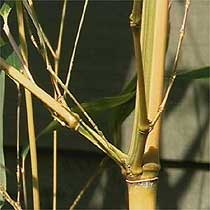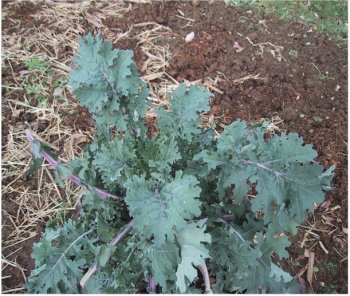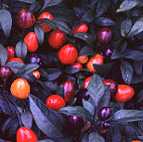





*Stealth Gardening Part 2*
Edible Landscaping Plants-Section 2-Veggies
By LabLover
21 May 2004
Veggies. Why add more to your landscape? Because you can! Edible Landscaping puts valuable growing space now used on posies to work for you. In tough times, every little bit more may make a difference. Stealth veggies may be the ones that other hungry folk pass by.
All the varieties below are available at many different on-line sites and local seed racks. One of my favorite and IMHO most reliable seed and garden suppliers is Johnny’s Selected Seeds in Albion, Maine. http://www.johnnyseeds.com/welcome.html (usual disclaimers apply- I’m just a very satisfied customer).
Johnny’s carries all the varieties below except the bamboo. Don’t just limit yourself to these varieties-consider other plants currently in your garden. How would that eggplant look in a clump of rose bushes? Try tucking a patio tomato into a container of flowers, add a cucumber vine to a hanging planter of petunias. Bush squash can often appear like tropical succulents when surrounded by flowers. Experimentation is fun, play around with the idea and you may be surprised just how many visually pleasing combinations you can come up with. Thinned vegetable seedlings taken from your garden rows are free testers. Tuck them into different spots and see how they look.






|
Beans- hyacinth Bean Dolichos Lablab scarlet Runner Bean Phaseolus cossineus |
|||||
|
Hardiness Zone |
Mature Height |
Water Requirements |
Light Requirements |
Disease Susceptibility |
Annual, Perennial, Biennial |
|
Some varieties perennial in frost free areas |
Vines 6-8’ Bush 2’ |
Moderate 1-2" week |
Sun, Some will tolerate light shade |
Moderate, but often produce even with moderate insect pressure |
Almost all grown as annuals. Die and stop producing if not picked and seed matures. |
|
Hyacinth bean produces a beautiful vine as tall as 20 ft in excellent conditions, young pods cooked as green beans, half mature eaten as shellies. Scarlet Runner comes in vine and bush varieties, and produces beautiful red flowers and "normal" green beans. Keep picked often to maintain production. Cascade over walls, hanging containers, and on fences and trellises for the vines, bush Scarlet runner tucked among flowers or bulbs can produce months of flowers and beans if kept picked. Tolerates dappled shade and has produced moderately well for me in the past with @ 4 hrs sun a day. A couple of beans can sneakily hide among other vining trellis plants and different colored flowers accent established vines beautifully. Try Hyacinth Bean on an arbor with grapes or ornamentals for attractive and productive shade. |
|||||
|
Bamboo various species, Phyllostachys aureosulcata "Yellow Groove" most hardy |
|||||
|
Hardiness Zone |
Mature Height |
Water Requirements |
Light Requirements |
Disease Susceptibility |
Annual, Perennial, Biennial |
|
Most species 7-10 Yellow Groove- zone 5-Others hardier, many specialty sites sell bamboo, check descriptions for edibility |
12-25’ |
Drought tolerant once established, keep well watered the first year |
Shade in hot areas, sun in cool coastal areas |
Few pests or diseases |
Perennial |
|
All prefer well drained loam with high organic content. Bamboo is a very multipurpose plant, considered "invasive" some species propagate by underground runners. (including Yellow Groove) A concrete header 2 ft deep will contain them. In cold climates not as invasive. Clumping types stay confined. Young shoots are cooked, and reputedly taste like sweet corn (unlike the flavorless canned product) Can be served as a boiled vegetable and are well known stir fry ingredients. The added utility of bamboo is the many things that can be made from it- in addition to the "cane pole" it has many uses on the homestead. Produces a stand of cool shade, screens areas fairly quickly, and creates a privacy screen quicker than trees. Running bamboo shoots in spring, and mounding soil up similar to asparagus produces shoots with larger blanched, edible areas. Bamboo may have a bitter taste; parboil 15-20 minutes to remove bitterness, changing water after the first 10 minutes. Can be preserved by parboiling then freezing; or parboiled, salted and dried. |
|||||
|
Swiss Chard- Beta vulgaris var. cicla |
|||||
|
Hardiness Zone |
Mature Height |
Water Requirements |
Light Requirements |
Disease Susceptibility |
Annual, Perennial, Biennial |
|
Tender, biennial in mild areas (@50% overwinters here in SC with mulch) |
12-24" |
Moderate |
Sun, will tolerate very light shade but may be smaller |
Relatively untroubled |
Biennial |
|
Tastier than many other greens, chard is mild without the metallic tang of spinach or the bitterness of the mustards, beets or kale. Can be cut off to harvest or "cut and come again" by leaving the small leaves in the center intact will keep producing. Rhubarb Chard has brilliant red stems and green leaves, most varieties light green or silver stems, but the most beautiful is Rainbow Chard, with bright yellow, red, fluorescent pink and orange stems (one color per plant, this one looks great scattered or clumped in bunches). Color fades in cooking, but when washed and lightly blanched is still pretty. Can replace all other greens in recipes. Produces tender leaves in hot summer conditions. One of my favorite vegetables for beauty and taste. Try sautéing a few slices of bacon, chopped onion and a little minced garlic till tender in a large Dutch oven, wash chard and toss into pot when still wet, reduce heat and stir with the bacon and onions, cover and let steam for a few minutes until ribs are fork tender. |
|||||
|
Kale- Red Russian Brassica oleracea |
|||||
|
Hardiness Zone |
Mature Height |
Water Requirements |
Light Requirements |
Disease Susceptibility |
Annual, Perennial, Biennial |
|
Annual, may overwinter in southern areas |
@ 12-24 inches before flowering- when it bolts to seed can go 5-6’ |
moderate |
sun |
tolerant |
Biennial |
|
One of the sweetest kales. Tender when boiled or steamed, young leaves good in salads. Frilly purplish and magenta plant that tucks in among other flowers and ornamental bushes beautifully. Especially pretty with yellow flowers such as daylilies. If it overwinters, it will surprise you by turning into a 5-6 ft monster the following spring and produce huge amounts of seed (ask me how I know!). If you plan to save seed, put the ones you want to harvest in an area where they will have 4 ft from the nearest plant and can grow that high safely. Heavy mulching protects them. Kale is very cold tolerant, and may stop growing but tolerates frost and is still tasty and can be harvested in even moderate winter conditions if kept in a protected cold frame. |
|||||
|
Jerusalem artichoke-Helianthus tuberous |
|||||
|
Hardiness Zone |
Mature Height |
Water Requirements |
Light Requirements |
Disease Susceptibility |
Annual, Perennial, Biennial |
|
2-9 Mulch in colder zones |
6-10’ |
Not picky, almost drought tolerant |
Sun, often grow wild near the edge of forest, probably escaped from old homestead plantings as was grown extensively in colonial times |
Very tolerant few problems |
Perennial |
|
Another invasive, rangy plant. Few uses in the garden since its as hard to get rid of as mint, but in the right place, is a great plant to have. Small yellow flowers. Frequent mowing of runners will keep it enclosed in an area, or plant in buried containers. Harvest after first frost. Can be left in ground and dug as needed. Ugly white knobby tubers are sweet and crunchy, used with dips salad or sliced thin like chips. Can be boiled and is close to white potatoes. The starch in ‘chokes is inulin, which is better for diabetics as is has a beneficial effect on blood sugar due to a low glycemic index. Thin sliced tubers can be dried and ground into a sweet flour used in breads. |
|||||
|
Peppers- Capsicum species |
|||||
|
Hardiness Zone |
Mature Height |
Water Requirements |
Light Requirements |
Disease Susceptibility |
Annual, Perennial, Biennial |
|
Annual Perennial in 10-11 |
1 ˝-3’ |
moderate |
sun |
moderate |
Grown as annual |
|
Many very beautiful species are used as landscaping accents. Some have variegated foliage, some purple leaves. Peppers can be small cherry types or little flame like hot peppers. Some ornamental" species are not edible, most are, purchase seed from plants also used for food. Besides the obvious use in cuisine, how pepper varieties have medicinal uses (ie, powdered to control bleeding or used in liniments for topical pain relief) and are actually good for the digestion. Dry, or can to preserve. Easy seed saving, avoid hybrids to be sure your seed will grow to type. |
|||||
All materials at this site not otherwise credited are Copyright (c) 1996-2004 Trip Williams. All rights reserved. May be reproduced for personal use only. Use of any material contained herein is subject to stated terms or written permission.